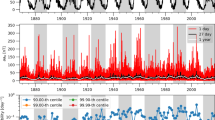Abstract
The influence of the solar corpuscular radiation on weather is demonstrated by characterizing the corpuscular impact by means of the geomagnetic aa-index and the terrestrial response by European temperature data. Considering different spatial and vectorial circumstances the following conclusions can be drawn: 1. the efficiency of the corpuscular impact depends on the Sun-Earth attitude (semiannual fluctuation); 2. this regularity depends on the polarity of the solar main magnetic dipole field; and 3. the whole complex of phenomena also depends on the geographic position - it exists at European middle latitudes but it does not exist in northern and southern Europe. We conclude that the periods of differently or oppositely working mechanisms should be separated in order to recognize the regularities.
Similar content being viewed by others
Author information
Authors and Affiliations
About this article
Cite this article
Baranyi, T., Ludmány, A. Role of the solar main magnetic dipole field in the solar-tropospheric relations. Part I. Semiannual fluctuations in Europe. Annales Geophysicae 13, 427–436 (1995). https://doi.org/10.1007/s00585-995-0427-y
Received:
Revised:
Accepted:
Issue Date:
DOI: https://doi.org/10.1007/s00585-995-0427-y




